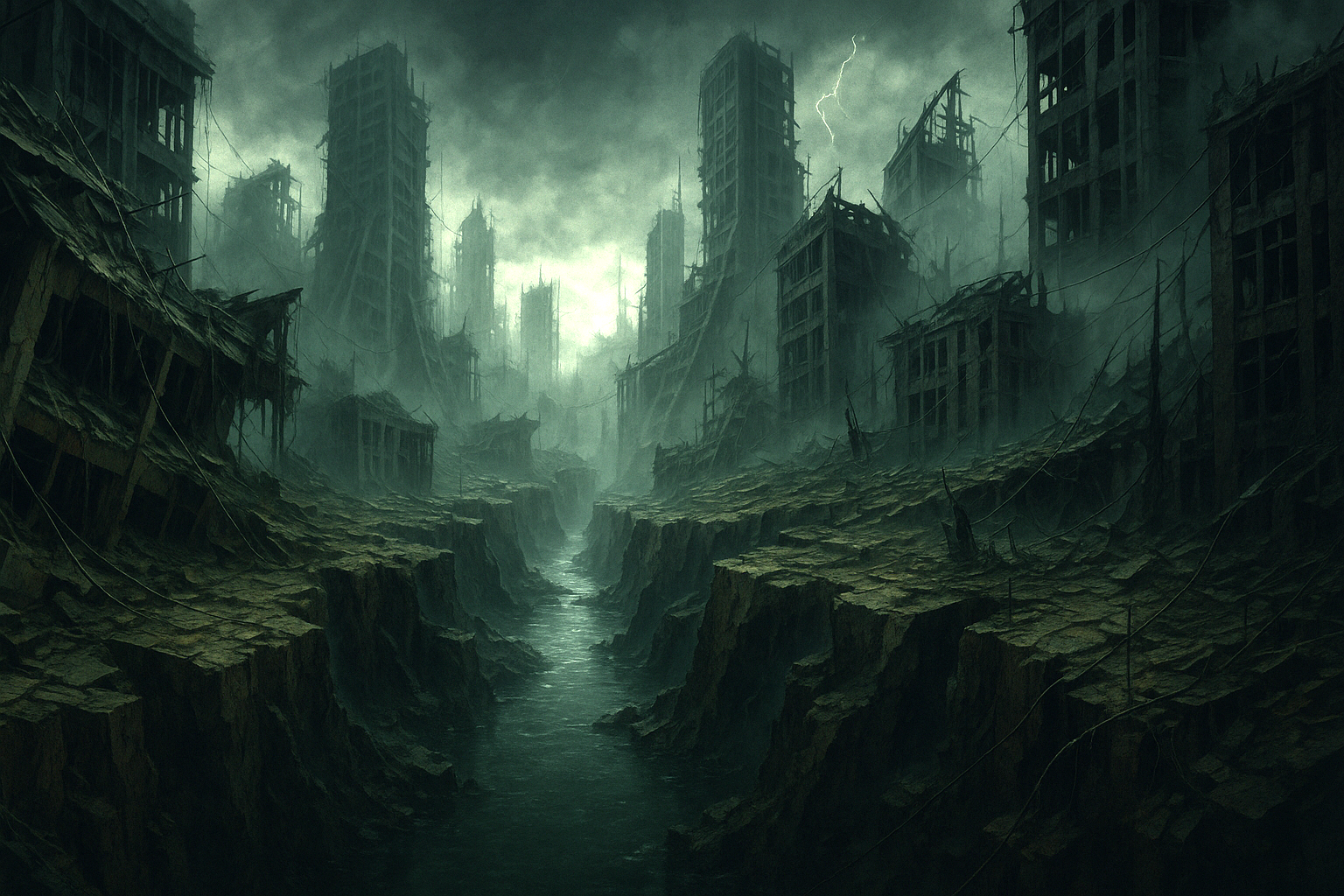The Drowned Trenches are a place of whispered warnings and sharp detours, etched into maps only to be circled in red and avoided. Their jagged banks and swells of fog mark the edge of reason, a place that repels even the desperate. Locals say the air hums wrong over the water, like something beneath is listening. Even crossing *above* the Trenches—by bridge, by boat, or by air—is seen as reckless. Compasses falter. Machinery shudders. People speak of unseen currents that drag sound, light, even thoughts down into the black.
Few dare near it, and fewer still return unchanged. The old roads that once passed close have long since been abandoned, choked by moss and superstition. Traders skirt miles out of their way to avoid the region, and scavenger crews that joke about testing their luck often go silent before they make it halfway there. The Trenches are not marked by walls or guards, but everyone knows: you do not go there. You *survive* by not going there.
Geography
Nestled in the fractured ruins of Albany, the Drowned Trenches consist of sunken boulevards, collapsed towers, and chasms filled with dark, still water. Enormous cracked fissures stretch for miles, sometimes plunging hundreds of feet into flooded subway lines, reactor tunnels, and hollow municipal caverns.
While surrounded by the wooded and overgrown highlands of upstate New York, the trenches themselves are stark and lifeless, with metal and glass strata exposed like bones, and broken utility lines hanging like vines. The Hudson River once flowed through this place but has since diverted and pooled, feeding the trenches with sluggish, silty water.
Localized Phenomena
- Thresher Mist, also known as The Fog That Remembers, emanates continuously from beneath the waterline, pooling in the air and forming conscious-seeming clouds. It clings to surfaces, refracts sound, and induces visions or seizures in the unprotected.
- Lightning strikes the area more frequently than statistically likely, often without storms—drawn to old-world metals and ferrous detritus beneath the water. Spontaneous magnetic surges can scramble compasses and short out electronics.
- Some travelers report hearing echoes of voices, old public announcements, or even screams in the mist—whether from natural acoustics, neural distortion, or something worse remains debated.
In the Drowned Trenches, the water remembers—what it touched, what it took, and what it made rot. We do not test it. We pray it forgets us.
Climate
The Drowned Trenches are consistently cold, damp, and stagnant, regardless of season. A wet chill hangs in the air even during the summer. Sunlight rarely penetrates the lowest depths, and dew forms on metal even without temperature shifts, suggesting high ambient humidity driven by Mist presence.
Rainfall is heavier than average here, and unnatural fog banks persist for days. Ice forms at unexpected elevations and can sometimes take on a glass-like, nerve-spun texture, possibly due to Mist condensation.
Natural Resources
The Trenches are dangerous but valuable:
- Rare neuro-reactive minerals used in Wake-Serum and dream technologies.
- Ancient biotech debris, sometimes recoverable from submerged labs or bunkers.
- Crystalized Thresher Mist, harvested by syndicate chemists and rogue engineers, if they can survive the trip.
- Old-world alloy veins, usable for specialist crafting and black-market exo-shell repairs.
Despite these, only the bold or desperate dare harvest here.
Every vial pulled from the Drowned Trenches costs a heartbeat, maybe more. But one drop of what sleeps down there can turn a plague, mend bone, or wake a mind lost to rot. That kind of miracle is worth drowning for.
Fauna & Flora
Very little flora survives within the Trenches themselves—only fungal networks, algae that shimmer under UV, and rare, bioluminescent moss clinging to rebar and glass.
Fauna is strange and sparse:
- Blind carrion birds roost along the outer walls.
- Mist-feeding insects, transparent and slow, swarm anything warm-blooded.
- Mist Leeches, a partially invisible species, feed off neural signals rather than blood.
Occasional sightings of Others, mutated or warped by prolonged exposure, have been recorded—moving slowly, uttering disjointed phrases, or appearing to follow unseen rhythms.
The flora down there blooms without light, and the fauna feeds without mercy. Nothing in the Trenches lives by rules we remember—but every petal and fang is a lesson in survival, written in venom and glow.
History
Once a thriving portion of Albany’s urban heart, the region was already under military lockdown when the Fall began. Buried drone hives, AI servers, and nanite silos were thought to lie dormant beneath.
In Year 8 SE, after a series of tremors and explosions, half the city collapsed inward. Entire neighborhoods sank. The death toll was never measured.
Since then, scavengers and fools have ventured in, lured by rumors of Old World caches and technological miracles, only to vanish—or return broken, mutated, or singing.
The Church of Hope declared the region forbidden ground in Year 24 SE.
The Doctors consider it a quarantine zone, due to Mist saturation.
The Syndicate calls it “The Womb of Fire,” a sacred source of vision and transformation.
Tourism
No official tourism exists. Still, people come:
- Hope dissidents and rogue Others, seeking awakening or oblivion.
- Wake Chemists, harvesting raw Mist and spiritual ephemera.
- Treasure hunters, in search of functioning AI cores, preserved libraries, or lost relics.
- Religious zealots, who believe the Mist can show the divine in its true, unfiltered form.
Most don’t return. Those who do come back... are changed.
Those who return from the Trenches don’t come back whole—they come back tuned. Their eyes don’t blink the same, their breath hums like it’s remembering the pressure. But they’ve seen the deep truths. And sometimes, they bring them with.





Comments